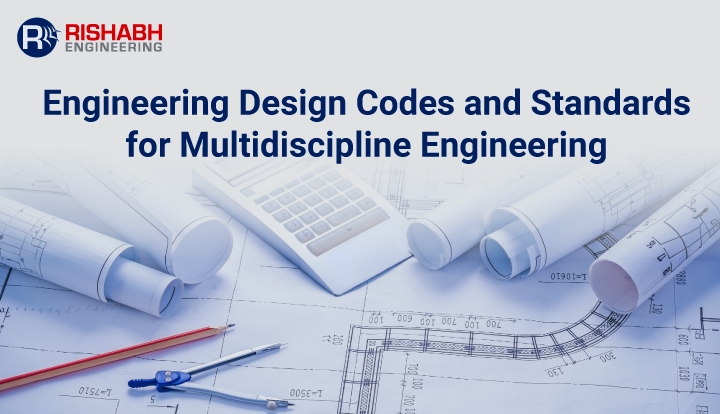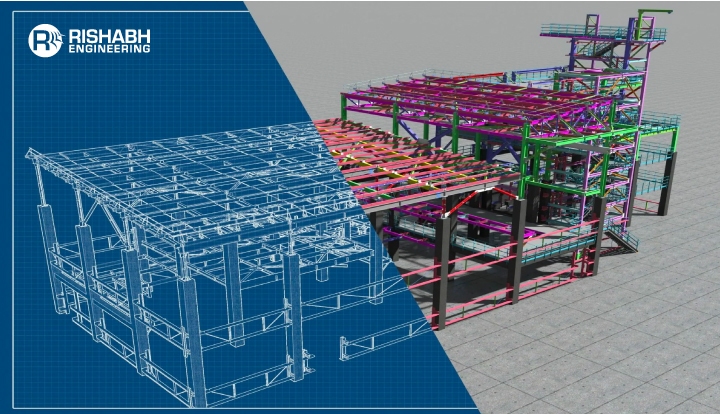
Engineering Design Codes & Standards For Multidisciplinary Engineering Projects
Design codes and standards are crucial in modern-day engineering as they help ensure project safety, quality, and consistency across various disciplines. Multidiscipline engineering companies like Rishabh Engineering rely on thoroughly understanding and applying these codes and standards to deliver successful client outcomes.
In this blog, we will discuss the key engineering design codes and standards practiced at Rishabh Engineering, highlighting their significance and application across various engineering domains.

What Are Engineering Design Codes And Standards & Why Are They Important?
Engineering design codes are collections of rules and regulations that regulate engineering systems’ design, construction, and use. And local and state governments often enforce them. Most importantly, the codes ensure that structures and systems satisfy the necessary safety and performance standards. In contrast, standards are rules that establish a consistent set of practices for engineers and contractors to follow. They are designed to deliver a level of quality.
Multidisciplinary engineering firms interact with team members from multiple engineering disciplines to solve unique project design difficulties. Detailed recommendations specify acceptable engineering project methodologies, materials, and practices. Professional associations and regulatory bodies produce regulations to ensure engineering projects’ safety, functionality, and consistency. To ensure the success of these initiatives, participants must have a solid awareness of the appropriate regulations and standards for each field.
Here are some of the reasons why the application of codes and standards is crucial;
- Safety: Protects public health and safety by minimizing the risk of failures and accidents.
- Quality: Ensures high-quality outcomes through standardized procedures and materials.
- Regulatory Compliance: Helps meet legal and regulatory requirements to avoid penalties and legal issues.
- Interoperability: Facilitates collaboration and compatibility across different systems and components.
Listed below are commonly applicable codes & standards used by multidisciplinary engineering companies;
Civil Engineering Design Codes & Standards
It encompasses compliance for designing, constructing, and maintaining infrastructure projects such as buildings, roads, bridges, and water supply systems.
- American Society of Civil Engineers (ASCE): ASCE 7 provides minimum design loads for buildings and other structures.
- American Concrete Institute (ACI): ACI 318 offers guidelines for designing and constructing structural concrete buildings.
- International Building Code (IBC): The IBC is a comprehensive building code with minimum requirements to safeguard public health, safety, and general welfare.
- Eurocode: A set of European standards for the structural design of buildings and civil engineering works.
Structural Engineering Design Codes & Standards
This would include conformity to design and analyze structures that support or resist loads.
- American Institute of Steel Construction (AISC): The AISC Manual of Steel Construction provides specifications for steel building structures.
- National Structural Code of the Philippines (NSCP): NSCP covers the design and construction of buildings and structures in the Philippines.
- Canadian Standards Association (CSA): CSA S16 provides guidelines for the design of steel structures.
- Eurocode 3: Standards for the design of steel structures.
Mechanical Engineering Design Standards & Codes
It involves correspondence to design and analyze mechanical systems.
- American Society of Mechanical Engineers (ASME): ASME Boiler and Pressure Vessel Code (BPVC) sets the standard for designing, manufacturing, and inspecting boilers and pressure vessels.
- International Organization for Standardization (ISO): ISO 9001 provides guidelines for quality management systems.
- American Welding Society (AWS): AWS D1.1 provides welding standards for structural steel.
- National Fire Protection Association (NFPA): NFPA 13 outlines the installation of sprinkler systems.
Electrical Engineering Design Codes & Standards
The said guidelines help study and apply electricity, electronics, and electromagnetism compliance.
- National Electrical Code (NEC): The NEC sets the standard for the safe installation of electrical wiring and equipment in the United States.
- Institute of Electrical and Electronics Engineers (IEEE): IEEE 802.3 sets standards for Ethernet networks.
- International Electrotechnical Commission (IEC): IEC 60364 provides guidelines for electrical installations.
- Canadian Electrical Code (CEC): CEC covers the standards for electrical installations in Canada.
Instrumentation & Control Engineering Design Codes & Standards
This compliance helps design and maintain systems that measure and control industrial processes.
- International Society of Automation (ISA): ISA 5.1 provides instrumentation symbols and identification guidelines.
- American Petroleum Institute (API): API 552 outlines the standards for process control systems.
- IEC 61511: Functional safety standards for the process industry sector.
Challenges in Applying Codes and Standards
While engineering design codes and standards provide a framework for ensuring the safety and quality of projects, applying them can often present challenges for multidiscipline engineering companies.
- One such challenge is staying current with the latest changes and revisions of these codes and standards.
- Another challenge is potential conflicts or inconsistencies between different codes and standards applicable to a single project.
Integration and Application of Engineering Design Codes & Standards
Integrating and applying the above-listed codes and standards across various projects requires a systematic and coordinated approach in a multidiscipline engineering company.
To effectively apply engineering design codes and standards in multidiscipline engineering projects, we at Rishabh Engineering employ the approach listed below:
- Establish a clear understanding of the relevant codes and standards applicable to each discipline involved in the project.
- Develop a comprehensive plan for applying these codes and standards throughout the design and construction process.
- Regularly review and update the project design to ensure compliance with the latest revisions to codes and standards.
- Foster a culture of collaboration and communication among team members from different disciplines to identify and resolve potential conflicts or inconsistencies in code and standard application.
- Invest in employee training and professional development to ensure they have the knowledge and skills to apply codes and standards effectively.
Final Words
Engineering design codes and standards are critical to ensure success for engineering projects across sectors. As technology advances and new issues arise, these rules and standards become increasingly important in multidisciplinary engineering. Organizations that remain on top of these changes and constantly improve their use of these codes will prosper in an increasingly complex and competitive market. At Rishabh Engineering, our detailed engineering services team considers the above-discussed design codes and standards as more than just a checklist to fulfill; they are an integral component of our mindset and project execution approach. Our dedication to understanding and properly applying these criteria allows us to provide exceptional results for our clients while also promoting public safety and encouraging innovation.
Seek help with Multidiscipline Engineering Projects?
Our experienced team with knowledge of engineering codes & standards can help you with design packages as per the project needs.
Related Blogs
Related Blogs
Best Structural Engineering Software for Accurate Analysis
Finding tools that simplify and improve the accuracy of the…
Detailed Engineering Considerations for Project Success
Engineering projects today require meticulous planning and execution across various…


